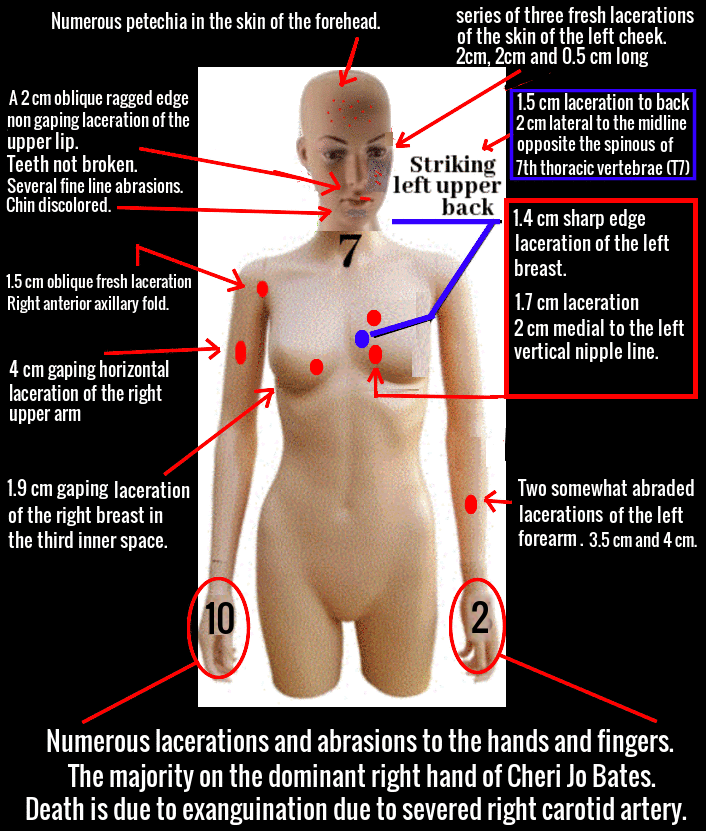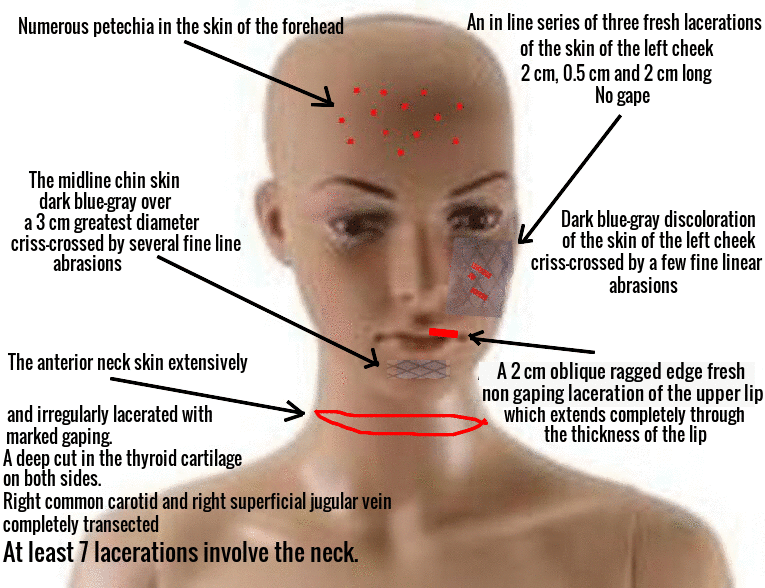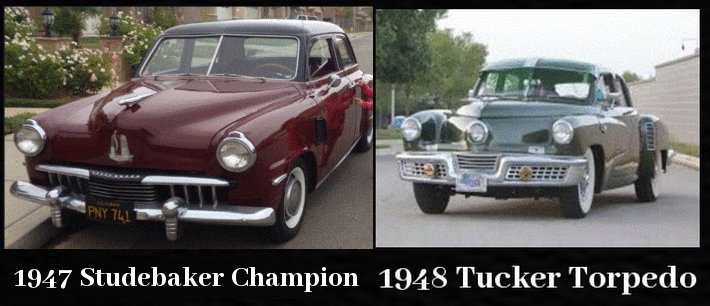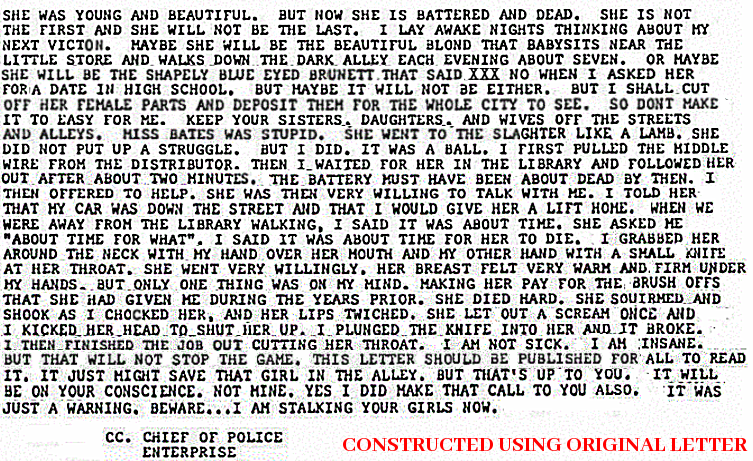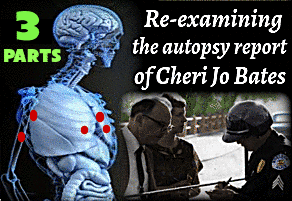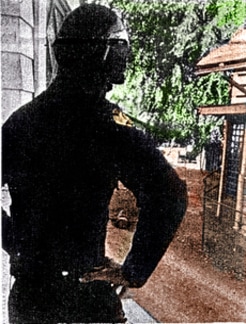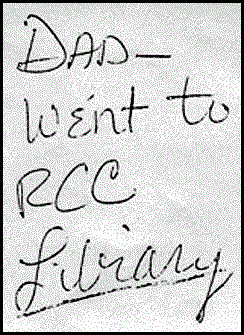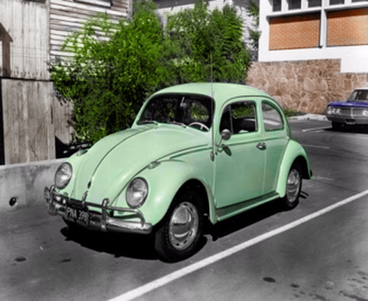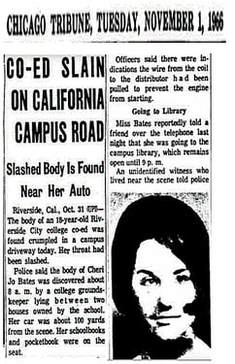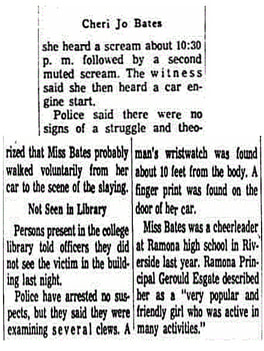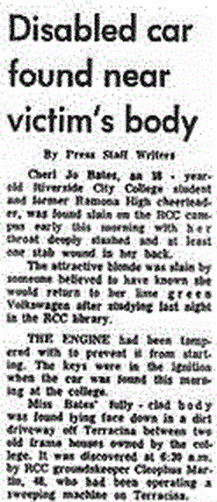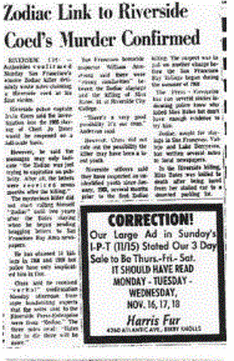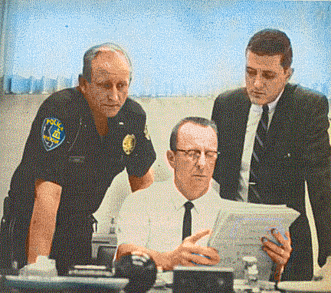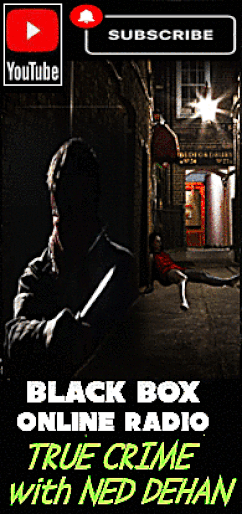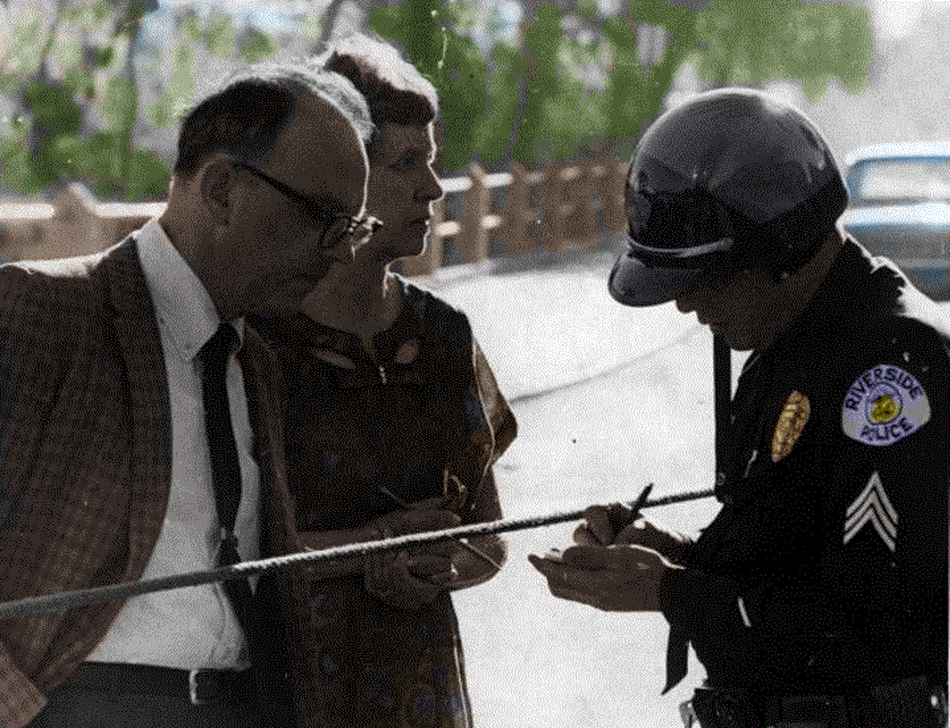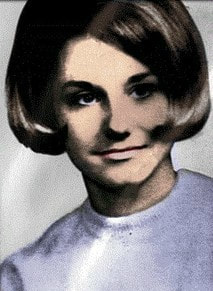 Cheri Jo Bates Cheri Jo Bates
THE COMPLETE EYEWITNESS TIMELINE MAP OF THE CRIME SCENE
Cheri Jo Bates (18), born in Omaha, Nebraska on February 4th 1948, was murdered on Sunday October 30th 1966 in a driveway beside the Riverside City College library, brutally attacked and killed as a result of a "severed right carotid artery due to laceration of neck due to probable knife" which measured a minimum of 3 1/2 inches long and one half inch wide (7 slice wounds to her neck in total). Despite many claims that Cheri Jo Bates was stabbed dozens of times and nearly decapitated, this is categorically untrue. She suffered between 6 and 9 stab wounds (left breast 2, right breast 1, right armpit, right upper arm, back, and 3 possible stab wounds to her hands). See autopsy report. The killer had sabotaged her Volkswagen Beetle car by tampering with the middle wire of her distributor with the intention of luring the young girl to her death. The Zodiac Killer linked himself to this crime on March 13th 1971 in a letter mailed to the Los Angeles Times, with a particularly vague claim of "riverside activity". However, the Zodiac Killer used this cryptic vagueness in several other claims, such as the murders of Kathie Reyne Snoozy, Debra Gaye Furlong, Sgt Richard Radetich, Koy Ien Saechao, Choy Fow Saelee, and the likely murder of Donna Ann Lass - none of which he provided any evidence for. His involvement in Riverside activity is poor at best. Cheri Jo Bates was a gregarious, outgoing woman who easily made friends, that could be seen as beneficial traits in her desire to become an air stewardess after graduation, where personality and social skills are key ingredients. This makes it even more strange that such a vivacious young woman, who by all accounts was in an amiable, humorous and sociable mood that day, could enter the Riverside College library shortly after opening time (6:00pm), check out three books from stocks and go unnoticed by virtually everybody in the cramped library annex, including her close friends who were present between 6:30 pm and 9:00 pm that evening. No testimony of the library attendees that night corroborate the widespread claims she left the library at its 9:00 pm closing time. In fact, in a reconstruction performed by police two weeks later on November 13th 1966, the majority of the 60+ people assembled do not remember ever seeing Cheri Jo Bates. The only two recollections were that of a Mexican-American student who noticed Cheri Jo Bates close to opening time and shortly after: who stated "he knew Cheri Jo Bates and had noticed her in the library the night in question. He said he saw the girl "writing something with a ball point pen in her blue spiral school notebook." The boy told us he was outside about 5:30 pm, waiting for the library to open at 6, and it was then he saw the girl", and a male librarian at the college said he "thought he saw" Cheri Jo Bates in the library that Sunday evening. What makes this crime even more unusual, is that nobody set eyes on the young woman from around the time the library opened at 6:00 pm that evening, until her body was discovered some 12 hours later, laying in a dirt driveway. WAS THE CONFESSION LETTER AUTHOR THE KILLER OF CHERI JO BATES? WAS THE CONFESSION LETTER AUTHOR THE KILLER OF CHERI JO BATES? [PART TWO] 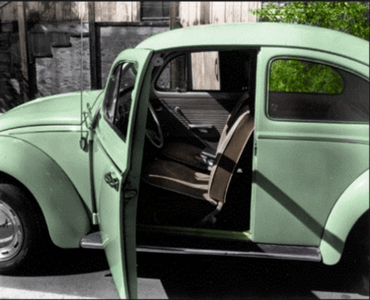 Click to enlarge and view the three library books on the front passenger seat. Click to enlarge and view the three library books on the front passenger seat.
Walter Siebert of 3667 Gloreen Court, who attended the library that evening, stated that "he and a few friends were in the library from 7:15 pm until 9, but did not see Miss Bates, whom they all knew. They said they saw four men dressed in work clothes sitting on a fence across from the spot where Miss Bates' car was found, but they did not know them". These four men were interrogated by police and said "they had seen Cheri Jo near her car the previous night". The four men, who viewed the young graduate that evening on Terracina Drive at approximately 6:00 pm when Cheri Jo Bates parked up, were again spotted in the same location at 7:15 pm by Walter Siebert and friends.
It doesn't matter if the four men spotted her at 6:00 pm or when she returned to her vehicle at any later time, because the 'interrogated' men did not recall or relay to police any information pertaining to Cheri Jo Bates being approached or accompanied by an unknown male, noticing her car being tampered with and disabled, any other car parked behind her, or her being abducted from the vicinity of her vehicle. In fact, they didn't relay any suspicious activity whatsoever, and may likely have been in this location between 6:00 pm and 7:15 pm, corroborated by themselves and Walter Siebert. The idea that she entered the library, her Volkswagen Beetle was then disabled, and upon her return failed to start the engine, before being aided by the 'good Samaritan' is patently false. The four men also never mentioned to police hearing any screams or cries for help that night, despite the dirt driveway where Cheri Jo was found murdered being only 225 feet (75 yards) from their location. Using the above eyewitness testimony, Cheri Jo Bates likely entered the library sometime between 6:00 pm and 6:30 pm, before her close friends arrived and while the library was relatively empty of students.  The stricken Cheri Jo Bates The stricken Cheri Jo Bates
On Halloween morning, groundskeeper Cleophus Martin (48) was traveling along Terracina Drive at 6:30 am, slightly west of the Riverside library annex, when he discovered the lifeless body of Cheri Jo Bates laying face down in the dirt driveway. Her body was discovered on the west side of the driveway, between two vacant properties. Cheri Jo Bates had been brutally attacked with a knife. There were signs of a violent struggle, evidenced by a churning of the driveway floor, with skin present under the young woman's fingernails and four brown Caucasian hairs found in a blood clot at the base of Cheri Jo Bates' right thumb, that in later years would reveal a mitochondrial DNA fingerprint. A Timex watch with a broken strap was discovered only ten feet from her body, likely wrenched off during the vicious attack. The Timex watch, which bore specks of household paint, presumed to be the offender's with its wristband broken, unfortunately failed to provide any clues to the killer's identity.
Screams were heard in the campus area from nearby residents, including the Sheri Lynn apartments, at approximately 10:15-10:45 pm - so if Cheri Jo Bates had entered the library at 6:00-6:30 pm and left immediately after checking out her library books, then she could not have simply been led away from her vehicle on the pretext of help and murdered in the driveway. The screams were heard approximately four hours later - and in addition, the numerous people entering and exiting the library from 6:00 to 9:00 pm that evening would surely have noticed the stricken Miss Bates despite the fact darkness had fell. Remember, Cheri Jo Bates was spotted in the area of the library shortly before and after 6:00 pm by several eyewitnesses.  Click to enlarge Click to enlarge
If Cheri Jo Bates had entered the library shortly after it opened and had left at 9:00 pm (upon its closing), it is inconceivable she could have spent upwards of two and a half hours inside the 'cramped' library annex and remained invisible for the entire duration to everybody inside it, including her close friends. Even had this been possible, we are left with literally 75-90 minutes from her leaving the library to the sound of the screams in the driveway. It certainly didn't take that long to walk from the library to her Volkswagen Beetle parked just 30 yards away, receive the 'assistance' from her attacker, and then travel back to the driveway where she was ultimately found murdered. Neither scenario makes any sense, so there has to be an alternative sequence of events. The location of Cheri Jo Bates from about 6:00 pm to 10:15-10:45 pm therefore has to lie elsewhere (assuming the screams were her). One has to speculate on the two vacant buildings either side of where Cheri Jo Bates was found, having recently been purchased by the college.
 The search for the murder weapon The search for the murder weapon
Would somebody known to Cheri Jo Bates and other students, or somebody familiar with campus grounds have been aware that these buildings were unoccupied, and at approximately 10:30 pm at night the risk of detection at this location was limited - something a stranger would be unaware of? Would a stranger or persons unknown to the area have begun an attack between two buildings and inflict numerous injuries on a screaming woman, not knowing if they were occupied? I suppose this was a question for the Zodiac Killer at Presidio Heights. The college was undergoing renovation and the Timex watch had paint splashes on it - so was it a crime of opportunity from somebody connected with the college?
A magazine publication dated January 1969 described the crime: "At the murder scene, drops of dried blood leading from the body to Terracina Drive were discovered indicated to the detective that the murderer had walked to the street following the slaying". This crime has many unanswered questions - in fact, nearly four hours worth.  Click to enlarge Click to enlarge
One month later, on November 29th 1966, a typed Confession letter would arrive claiming responsibility for the murder of Cheri Jo Bates and bragging about the crime. Exactly six months after the murder, on April 30th 1967, three letters were sent to Joseph Bates (Cheri's father), Riverside Press Enterprise and Riverside Police. They were very short in nature. Two contained the words "Bates had to die there will be more", but the letter to Joseph Bates stated "She had to die there will be more". Furthermore, a morbid poem was discovered written in blue ballpoint pen on the underside of a plywood folding desktop at the Riverside City College library, discovered by a janitor in the December of 1966.
Questioned Documents Examiner Sherwood Morrill, who analyzed many of the Zodiac letters, would link the Riverside correspondence to the Zodiac Killer. However, not everybody is convinced that the Cheri Jo Bates murder is connected to the attacks in the Bay Area. The Desktop Poem is only 45 words in length (including the title), and the 3 Bates letters were only 8 words in length. Yet both these communications had one thing in common with each other and the Confession letter. They all contained the phrase "to die", suggesting that it would be very unlikely for two or three separate authors to have created these communications, in absence of these being published in the newspapers at the time. Riverside Desktop Poem: "Sick of living/unwilling to die". Confession Letter: "I said it was about time for her to die". Bates Letters: "Bates had to die" and "she had to die". The title of the Riverside Desktop Poem also contained the adverb of "unwilling", the root of which is used twice in the Confession letter, when the author typed "She was then very willing to talk to me" and "She went very willingly". The use of the word "sick" in the Riverside Desktop Poem title was also present in the Confession letter when the author typed "I am not sick". Therefore, we have several words in the title of the Riverside Desktop Poem that featured heavily in the Confession letter. Another feature of the Riverside Desktop Poem was the use of "just wait till next time", implying an impending death. This would mirror the promise of impending death in the Confession letter of ."When we were away from the library walking, I said it was about time. She asked me "about time for what". I said it was about time for her to die". The Riverside Desktop Poem also stated "she won't die, this time someone'll find her". The word "time" used five times in total through two communications. READ FULL STORY
The following is a comprehensive analysis of the timeline of Cheri Jo Bates' movements and eyewitness testimony from the evening of October 30th 1966. It will not attempt to promote or discredit any of the reported statements. This timeline (slightly adapted ) will incorporate the testimony of an Air Force man and a friend of Cheri Jo Bates at about 6:10 pm, taken from the book of Robert Graysmith. These two accounts were discounted in the overview detailed above.

A Mexican-American student: stated 'he knew Cheri Jo Bates and had noticed her in the library the night in question. He said he saw the girl "writing something with a ball point pen in her blue spiral school notebook". The boy told us he was outside about 5:30 pm, waiting for the library to open at 6, and it was then he saw the girl'.
The library opened at 6:00 pm - and it was only then he noticed Cheri Jo Bates, indicating that Cheri Jo entered the library close to opening time (or several minutes after). His attention to detail mentioning the 'blue spiral notebook' could easily have been verified by police in order to corroborate that he wasn't mistaken. In addition to the Mexican-American student, a male librarian at the college said he "thought he saw" Cheri Jo in the library that Sunday evening. 
Detective Sergeant David Bonine stated that a close friend of Cheri Jo Bates saw her drive past in her lime green Volkswagen Beetle at approximately 6:10 pm, heading toward the Riverside City College on Magnolia Avenue. The friend waved at her but apparently she failed to notice and did not reciprocate the gesture. A second report from about the same time period was relayed to police from an Air Force man who lived close to Riverside City College library. He was passed by a lime green Volkswagen Beetle, driven by a blond female up an alley parallel to Magnolia and east of the Shelly-Lynn Apartments. Her vehicle was being followed by a 1965-66 bronze Oldsmobile. This must have been slightly after 6:10 pm, indicating that Cheri Jo Bates was heading to the library to park up.
Her vehicle was ultimately found on Terracina Drive close to the library entrance, which joined Magnolia Avenue on its western edge. If we assume she discharged her own three library books, then she must have entered the library at approximately 6:15 pm. The above two eyewitnesses times are approximated, so if the Mexican-American student saw Cheri Jo Bates "in the library the night in question," shortly after it opened, it was likely closer to 6:15 pm. However, this is dependent on the account portrayed by Robert Graysmith being correct. 
Shortly after 6:10 pm, four young men under police interrogation stated "they had seen Cheri Jo near her car the previous night". They didn't recall any suspicious activity around the Volkswagen Beetle that evening, so the claim she was abducted as she arrived on Terracina Drive, or had returned to a disabled Volkswagen Beetle could not have happened during the time they were sitting on the fence opposite her vehicle. They were later spotted by other eyewitnesses in exactly the same location. The time the four young men spotted Cheri Jo Bates has been approximated at 6:13 pm, likely when she had exited her vehicle to take the short walk to the library. It couldn't have been on her return, because if somebody had tampered with her vehicle during her absence and she had failed to start the Volkswagen Beetle, this would have been relayed to police by the four young men - which they apparently did not.
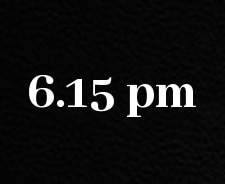
Cheri Jo Bates entered the Riverside City College library and took out three library books. The Mexican-American student noticed her outside the library. The male librarian thought he saw her in the library.
Extract from the November 29th 1966 'Confession' letter "I first cut the middle wire from the distributor. Then I waited for her in the library and followed her out after about two minutes. The battery must have been about dead by then. I then offered to help. She was then very willing to talk to me. I told her that my car was down the street and that I would give her a lift home. When we were away from the library walking, I said it was about time she asked me, "about time for what?". I said it was about time for her to die". The four young men sitting opposite Cheri Jo Bates' Volkswagen Beetle never saw anybody tamper with the engine. The four young men were still sitting on this fence at 7:15 pm, one hour after seeing Cheri Jo Bates park up. Therefore, the only way the author of the 'Confession' letter may be proved correct, is if the four young men left that location shortly after spotting Cheri Jo Bates leave her vehicle, only to return to the same spot some time later. In other words, the four men notice the young woman leave her vehicle, they walk away from the near vicinity - at which point the assailant disables the Volkswagen - who then waits for Cheri Jo Bates to offer her assistance, then murders her in the alleyway, likely before 6:30 pm. The four young men then return to the original location after 6:30 pm, and before 7:15 pm, hence see or hear nothing untoward. However, this is not possible, because a later eyewitness supposedly present in the alleyway at 9:30 pm saw no signs of murder. 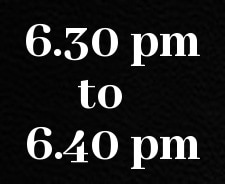
'Other students who were acquainted with Cheri Jo said they were in the library between 6:30 pm and 6:40 pm, and did not see the girl during that time'. This suggests that Cheri Jo Bates had entered the library at approximately 6:15 pm, then had discharged her reading material and exited the vicinity of the library annex by 6:29 pm at the latest. Had she traveled back to her Volkswagen Beetle at this point, it is likely her friends would have spotted her by the stricken vehicle. Had she left the library slightly earlier at 6:20 pm, finding her car unresponsive, it is likely she would have returned to the library for assistance or to make a phone call. She could not have immediately been lured away and murdered in the alleyway, as her body was not lying in the alleyway up to 9:30 pm, which was apparently corroborated by a female eyewitness.
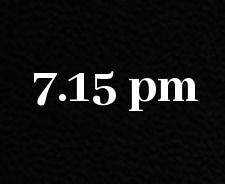
Walter Siebert stated that 'he and a few friends were in the library from 7:15 pm until 9, but did not see Miss Bates, whom they all knew. They said they saw four men dressed in work clothes sitting on a fence across from the spot where Miss Bates' car was found, but they did not know them'. This indicated that four young men were present from 6.15 pm through to 7:15 pm opposite Cheri Jo Bates' Volkswagen Beetle, or had left and returned by 7:15 pm. Walter Siebert and friends recall the four men, but not Cheri Jo Bates, further indicating that the four men must have spotted Cheri Jo at approximately 6:13 pm, when she arrived at Terracina Drive to enter the library. The vehicle had still yet to be disabled at this point.
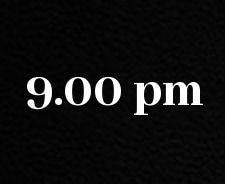
The library shuts and the remaining patrons leave the building. There is still no sign of Cheri Jo Bates.
Zodiac Unmasked by Robert Graysmith: 'Cheri Jo checked out three books from the local college library. Though her friends were at the small, cramped library between 7:15 pm and 8:57 pm, none recalled seeing her there. At 9:00 pm when the archives closed, she returned to her car to discover the engine would not catch. And here she had been working part-time at the Riverside National Bank. Parked behind her car was a Tucker Torpedo that was not there before'. Some of this is clearly not true, because if nobody saw her, how could she have been seen returning to her vehicle at 9:00 pm. The mention of the Tucker Torpedo is interesting however, since only 51 vehicles were ever made before the company folded in 1949. The eyewitnesses may have mistaken the make of the vehicle - but if not - the screams heard later in the alleyway, closely followed by the sound of an old vehicle pulling away, may have a bearing. The Daily Enterprise, Riverside 1966: 'Detectives investigating the murder of Cheri Bates are looking for a car almost identical to this one. Police say a 1947-52 model Studebaker with light-colored, oxidized paint was parked on Riverside Avenue just south of Terracina Drive about 7 p.m. on the night that the Riverside City College freshman was stabbed to death. Detectives said a recent re-enactment of the murder at the college campus provided this information. They ask anyone who knows of a car similar to this one, used by police to stage this photograph, to contact the Police Department'. Since the Tucker Torpedo was supposedly spotted behind Cheri Jo Bates' Volkswagen Beetle when people were leaving the library, with both vehicles facing the library, it could be argued that the witnesses to the Tucker Torpedo only saw its front end. Both the Tucker Torpedo and Studebaker have similar aeroplane front end characteristics. Could these vehicles have been mistaken as one? 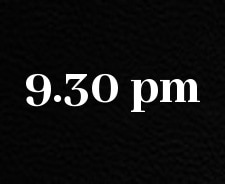
At approximately 9:30 pm, a female student purportedly noticed a man standing in the fateful alleyway smoking a cigarette and exchanged brief greetings with him. She later failed to identify anybody from a photographic line-up, including 'Bob Barnett', the prime suspect in the Riverside Police Department investigation. He would later be excluded using mitochondrial DNA retrieved from blood-clotted hair found at the base of Cheri Jo Bates' right thumb. The female student eyewitness was certainly credible enough to police, because they later retrieved a cigarette butt from the alleyway close to where the man was last seen standing. It was listed in the Riverside DNA evidence analysis report. The cigarette butt had a DNA concentration of 0.003 nanograms per microliter. The question is, could the cigarette DNA be ruled out from the DNA recovered from the base of Cheri Jo Bates' thumb? Was this man waiting in the alleyway for Cheri Jo Bates to return to her vehicle? Was he expecting her to have been in the library, but when she didn't exit the library at 9:00 pm he hung around the shadows of the alleyway with one eye on her vehicle?
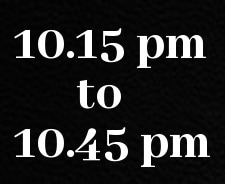
Screams were heard coming from the vicinity of the alleyway sometime between 10:15 pm and 10:45 pm. The newspapers reported that 'A neighbor heard an awful scream between 10:15 pm and 10:45 pm, and then about two minutes of silence, and finally the sound of an old car starting up. A man returning to the area at 10:30 pm told us he heard two screams then'. If these details are accurate, then was the killer returning to his old 1948 Tucker Torpedo parked just behind Cheri Jo Bates' Volkswagen Beetle? This would have been parked approximately 250 feet from the alleyway if the eyewitness report is to be believed. So why the two minutes of silence? Was he frantically searching in the darkness for the Timex watch yanked from his wrist?
In a magazine dated January 1969, it mentioned that "At the murder scene, drops of dried blood leading from the body to Terracina Drive were discovered indicated to the detective that the murderer had walked to the street following the slaying". This would certainly be the right direction to his vehicle, had he parked it behind the Volkswagen Beetle. A female earwitness described "an awful scream between 10:15 pm and 10:45 pm, and then about two minutes of silence, and finally the sound of an old car starting up". If the author of the Confession Letter was really the killer of Cheri Jo Bates, can we estimate the location of his vehicle, assuming the earwithness was hearing the actual murder take place? By combining the direction of the blood trail to one side of Terracina Drive, with the two minute interval from "scream to vehicle starting up", we can use the details in the Confession Letter to pinpoint fairly accurately the location of his vehicle. The Confession Letter stated "She let out a scream once and I kicked her in the head to shut her up. I plunged the knife into her and it broke. I then finished the job out cutting her throat". If this is when he "finished the job out" before leaving the scene, then he had two minutes to "kick her in the head, plunge the knife into her, cut her throat" and walk to his waiting vehicle (assuming he isn't searching for the watch). Allotting about 45 seconds at the murder scene, he has approximately 75 seconds to negotiate the 100 feet to Terracina Drive, and the rest to reach his vehicle. Traveling at an average walking speed of 1.4 meters per second, the 100 feet (30.48 meter) journey would take about 22 seconds, leaving 53 seconds walking time on Terracina Drive. That would mean a vehicle parked 243 feet (74 meters or 81 yards) from the driveway. Cheri Jo Bates' Volkswagen Beetle was parked 75 yards (68 meters) east of the driveway, just beyond the library annex. This rough estimate, would place the killer's vehicle only 6 yards (18 feet) behind the vehicle of Cheri Jo Bates (had he exited the driveway east) - the ideal spot to offer her assistance when her vehicle failed to start - and the near exact location of the Tucker Torpedo (or Studebaker) described in Robert Graysmith's book. 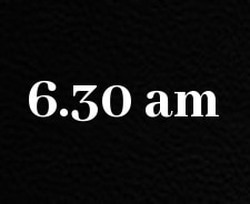
On Halloween morning, groundskeeper Cleophus Martin (48) was traveling along Terracina Drive at 6:30 am, slightly west of the Riverside City College library annex, when he discovered the lifeless body of Cheri Jo Bates lying face down in the dirt driveway. The young Ramona High School graduate had been 'missing' for just over 12 hours. Although she had received only four knife wounds to her torso with limited penetration, this shouldn't detract from the brutality of this crime. The autopsy shows, in total, there were either 12 or 13 incised knife wounds to the torso, arms and hands of Cheri Jo Bates, as opposed to the misguided and common misconception stating 42 stab wounds inflicted on the young woman.
Five days later, her grief stricken father Joseph Bates collapsed at her funeral, inconsolable at the loss of a daughter who had so much to live for, but whose life was cruelly snatched away on October 30th 1966 by a coward who lurked in the shadows - and a coward that has done so ever since. Here is an article from Zodiac news, expanding on the Cheri Jo Bates case, including the autopsy findings. CHERI JO BATES-THE AUTOPSY FINDINGS 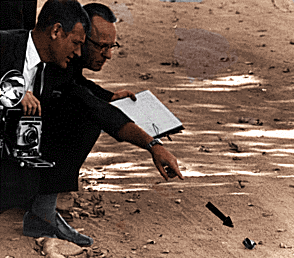 Click to enlarge Click to enlarge
The Cheri Jo Bates murder on October 30th 1966 has been linked to the Zodiac crimes, but unlike the Zodiac murders this crime has gaping holes in the timeline that have yet to be fully explained. Cheri Jo Bates simply went off the radar for at least 12 hours, from around 6:15 pm on Sunday evening to the following morning, when her lifeless body was discovered by Riverside City College groundskeeper Cleophus Martin at 6:30 am.
The time of the murder has been estimated between 9:15 pm and 10;45 pm based on eyewitness reports and autopsy findings. One woman from a nearby residence stated that about 10:30 pm "I heard a muted scream, and then a loud sound like an old car being started up - this was about two minutes after I heard the first scream". Other eyewitnesses would corroborate the time between 10:15 pm and 10:45 pm, suggesting that the idea people failed to adjust for daylight savings, sending the clocks back the previous midnight, highly unlikely. Placing the murder at 9:15 pm sounds more plausible, based upon the fact the library closed at 9:00 pm, however, considering Cheri Jo Bates arrived at the library shortly after 6:00 pm, this places her in the library for nearly three hours, yet only one person "thought he saw her" in the library during this period. Cheri Jo Bates' liver temperature was recorded at 26C and 28C at 9:31 am on October 31st 1966 at autopsy. Algor Mortis is the rate at which a body cools after death - very little during the first hour, but calculated thereafter at 1.5 degrees Fahrenheit per hour, dependent on ambient temperature, body size, clothing etc. The temperature in Riverside that day hit a maximum 97 degrees Fahrenheit, falling to 52 degrees Fahrenheit at its lowest, giving us an idea of ambient temperature during this period. There was also little to no wind at this time, therefore not adversely affecting the rate of body cooling. Taking normal body temperature of 98.6 degrees Fahrenheit and Cheri Jo Bates median liver temperature of 80.6 Fahrenheit at 9:31 am, we can calculate the approximate time of her murder, The body of Cheri Jo Bates had cooled by 18 degrees at autopsy - but not counting the first hour - this would take 12 hours (18÷1.5). Then if we add back the first hour, it gives us a time period of 13 hours. This would mean Cheri Jo Bates was murdered at approximately 8:31 pm or slightly earlier, as body cooling actually slows down in rate, as it approaches the ambient temperature. If we take the high end measurement of her liver temperature of 82.4 Fahrenheit at autopsy, it places the murder at approximately 9:31 pm, or again slightly earlier, bearing in mind the existence of a "temperature plateau" (a highly variable length of time in which the body does not cool). Taking the bottom measurement liver temperature of 78.8 Fahrenheit, that is a drop of nearly 20 degrees (20÷1.5 =13.33) and just over 14 hours since the time of death, including the first hour - thereby giving us a murder at approximately 7:31 pm. Joseph Bates arrived back at the 4195 Via San Jose residence around 5:00 pm, finding the note left by Cheri Jo Bates of "Dad-Went to RCC Library". Cheri was spotted at the RCC Library around 6:15 pm. This is crucial because the pathologist F. Rene Modglin stated "the gastric contents suggest she had eaten a supper type meal probably not more than 2 to 4 hours before death". In addition, the stomach contents contained "at least 100ml of thick fluid, with particulate food particles in which are easily recognized reasonably large pieces of beef, along with vegetable particulates and/or celery and onion, and what appears to be milk or cottage cheese". Cheri Jo Bates consumed this meal prior to 5:00 pm, before Joseph Bates arrived home. Food takes approximately 2-5 hours to leave the stomach, depending on its constitution. The pathologist stated she had eaten not more than 2 to 4 hours before her death. This means if Cheri Jo Bates ate this meal at approximately 4:30 pm, then she would have been killed sometime between 6:30 pm and 8:30 pm, tying in with the findings of body temperature above and the indication of an earlier murder. 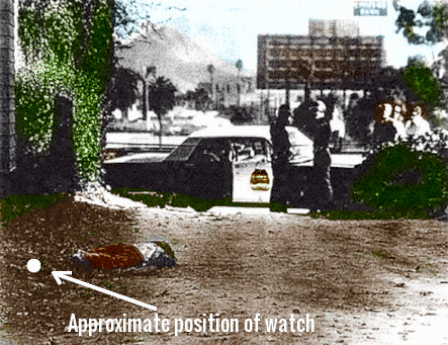
This would match the Confession letter on November 29th 1966, if Cheri Jo Bates arrived at the library at 6:15 pm, checked out her books immediately and was followed to her vehicle, before being killed around 6:30 pm.
The author stated "Miss Bates was stupid. She went to the slaughter like a lamb. She did not put up a struggle. But I did. It was a ball. I first cut the middle wire from the distributor. Then I waited for her in the library and followed her out after about two minutes. The battery must have been about dead by then. I then offered to help. She was then very willing to talk to me. I told her that my car was down the street and that I would give her a lift home. When we were away from the library walking, I said it was about time. She asked me, "about time for what?". I said it was about time for her to die". However, this throws up an unlikely scenario, that 65 people entering and leaving the library that night between 6:00 pm and 9:00 pm, would fail to spot the stricken Miss Bates lying in the driveway for at least 2 1/2 hours. Even if the murder occurred at 7:30 pm or 8:30 pm, we still have a problem - particularly in light of screams being heard at 10:30 pm at night by local residents. Additionally, we have the female eyewitness who allegedly spotted a man smoking in the alleyway at 9:30 pm, and Cheri Jo Bates' body not being viewed. But a 10:30 pm murder leaves us back where we started, four long hours to explain, and seemingly contradictory to the body temperature and stomach analysis described above. |
This is a photograph of the watch after being taken into evidence. It now reads 12.23. The watch did not stop functioning in the aftermath of the attack. This is a widespread misconception. Timex watches were extremely common in the 1960s and the origin of this watch has yet to be fully determined. The idea it was purchased in England cannot be substantiated.
The wristband was measured at 7 inches and had broken away from the upper face of the watch, most likely during the attack on Cheri Jo Bates. Small flecks of white paint were discovered on the watch, leading some observers to believe the assailant may have been involved in the renovation of the Riverside campus just prior to the brutal murder. Cheri Jo Bates Volkswagen Beetle was found parked approximately 30 yards east of the library annex, parked on Terracina Drive. When discovered by police her vehicle was unlocked, the windows were rolled down, her keys were still in the ignition and her library books lay on the front passenger seat. Surely if Cheri Jo Bates had vacated her vehicle to call for assistance or had left voluntarily on the offer of help, she would have secured her vehicle first.
All
13 Hole Postcard 148 Character Cipher 1978 Letter 1986 Letter 1987 Letter 2001 Happy New Year Card Albany Letter Allan/Peyton Murders Arthur Leigh Allen Betsy Aardsma Blue Rock Springs Attack Bus Bomb Letter Button Letter Call To Chat Show Cheri Jo Bates Cipher Theories Citizen Card Concerned Citizen Card Confession Letter Debut Of Zodiac Letter DMV Letter Domingos/Edwards Murders Donald Lee Bujok Donna Lass Dragon Card Earl Van Best Jr Eureka Card Exorcist Letter Fairfield Letter Fingerprint Evidence Forecast For Cancer Forecast For Leo General News Articles Gilbert And Sullivan Halloween Card Hood/Garcia Murders Internet Articles Kevin Robert Brooks Lake Berryessa Attack Lake Herman Road Murders Lake Tahoe Disappearance Larry Kane Los Angeles Letter Melvin Belli Letter Mike Morford (Morf13) Modesto Attack Molina/Rodriguez Murders Monticello Card My Name Is Letter Pines Card Possible Zodiac Attacks Possible Zodiac Letters Post An Article Here Presidio Heights Murder Radians Red Phantom Letter Richard Gaikowski Riverside Desktop Poem Robert Salem Murder Ross Sullivan Saechao/Saelee Murders San Jose Code Letter Scotch Tape Letter Sla Letter Tamalpais Valley Attack Ted Kaczynski Telegraph Avenue Incident The 340 Cipher The 408 Cipher The Celebrity Cypher The Little List The Mikado Thomas Horan You Are Next Letter Zodiac Letters Poll Zodiac Theories 1963 June 4th-The Domingos/Edwards Murders
1966 Oct 30th- Cheri Jo Bates Murder 1966 November 29th- Confession Letter 1966 December- The Desktop Poem 1967 April 30th- The Three Bates Letters 1968 Dec 20th- Lake Herman Murders 1969 July 4th- Blue Rock Springs Attack 1969 July 31st- Vallejo Times-Herald Letter and 408 Cipher Page1 (solved) 1969 July 31st- Examiner Letter and 408 Cipher Page 2 (solved) 1969 July 31st- Chronicle Letter and 408 Cipher Page 3 (87% solved) 1969 July 31st- The Complete 408 Cipher 1969 Aug 3rd- Snoozy & Furlong Murders 1969 August 4th- Debut of Zodiac Letter 1969 Aug 10th- Concerned Citizen Card 1969 Sept 27th- Lake Berryessa Attack 1969 Oct 7th- The Good Citizen Letter 1969 Oct 11th- Presidio Heights Murder 1969 October 13th-The Paul Stine Letters 1969 October 14/15th- Zodiac Call to Santa Rosa 1969 Oct 21st- Phone Call to Palo Alto 1969 October 22nd- Call to Chat Show 1969 November 2nd- Daniel Williams Poisoning 1969 November 8th-The Dripping Pen Card and 340 Cipher (solved in 2020) 1969 November 9th-The Bus Bomb Letter 1969 November 19th-The Riddler Notes 1969 Nov 21st-The San Jose Code Letter 1969 Nov 28th- Betsy Aardsma Murder 1969 December 7th- Oklahoma Radio Call 1969 Dec 7th-The 1st Fairfield Letter 1969 Dec 10th- Forecast for Cancer 1969 December 11th- Forecast for Leo 1969 Dec 16th-The 2nd Fairfield Letter 1969 Dec 19th- Zodiac Call to San Jose 1969 Dec 20th-The Melvin Belli Letter 1970 Jan 4th- Call to Peggy Trainer 1970 Feb 21st- The Hood and Garcia Murders 1970 March 22nd-The Modesto Attack 1970 April 15th-The Robert Salem Murder 1970 April 20th-"My Name is" Letter, Cipher 3 and Bus Bomb Diagram 1970 April 28th-The Dragon Card 1970 June 18th- Oakland A's Letter 1970 June 26th-The Button Letter Cipher 4 and Map 1970 July 4th-The Sleeping Bag Murders 1970 July 24th-The Kathleen Johns Letter 1970 July 26th-The Little List Letter 1970 Sept 6th-The Donna Lass Disappearance 1970 October 5th-13 Hole Postcard 1970 Oct 17th- "You Are Next" Postcard 1970 October 27th-The Halloween Card 1971 March 13th-The Los Angeles Letter 1971 March 22nd-The Pines Card 1971 May- The 148 Character Cipher 1971 July 13th-The Monticello Card 1972 June 29th- The Novato Letter 1973 August 1st- The Albany Letter 1974 January 29th-The Exorcist Letter 1974 February 3rd-The SLA Letter 1974 May 8th-The Citizen Card 1974 July 8th-The Red Phantom Letter 1974 December 27th- Christmas Card 1975 November 3rd- The Belmont Letter 1976 August 26th- Deep Real Estate Ad 1978 Mar 13th- "I Am Back" Phone Call 1978 April 24th-The 1978 Letter 1978 May 2nd- The Channel Nine Letter 1978 July 19th- The Scotch Tape Letter 1981 March 8th- The Atlanta Letter 1982 January (?) - The Santa Claus Card 1986 May 6th- The Freeway Letter 1987 October 28th- The 1987 Letter 1988 February 1st- McDonald's Letter 1988 February 8th- McDonald's Letter [2] 1990 Sept 25th- The Celebrity Cypher 1990 Dec- American Greetings Card 1991-Scorpion Ciphers to John Walsh 2001 Jan 10th- Happy New Year Card DMV Letter (possibly November 1971) |
| ZODIAC CIPHERS |
|

